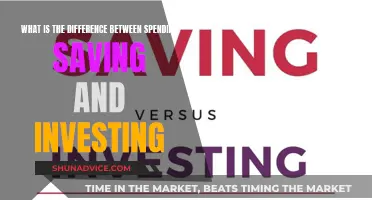
Credit cards can be a powerful tool to boost your investments and build wealth. While it is generally not recommended to invest with a credit card due to the high risk of accumulating debt, there are some strategies you can use to make investments with your credit card. Here are some ways to make investments using your credit card:
- Using credit card rewards: Some credit cards offer rewards or cashback on spending, which can be used to invest in stocks or ETFs. This approach does not involve direct borrowing but can be a way to use your credit card for investing.
- Short-term financing: If you are confident that a stock will increase in value in the near future, you can use your credit card for investment purposes. However, this strategy is highly risky and speculative.
- 0% credit promotions: Taking advantage of 0% APR credit card promotions can provide you with access to credit at no additional cost for a limited period. This option is usually available to those with excellent credit histories and allows you to leverage your credit line for other investment strategies.
- Flipping items: Flipping, or retail arbitrage, involves using your credit card to purchase items at a lower cost and then reselling them for a higher price before interest accrues. This strategy requires research and quick turnover to avoid interest charges.
- Maximizing welcome bonuses: Some credit cards offer lucrative sign-up bonuses, such as bonus points or cashback, for new cardholders who meet certain spending requirements. These rewards can be used for statement credits, travel, or other investments.
- Racking up cash rewards: Using a cash-back rewards card for day-to-day expenses can help you earn money back on each dollar spent. The accumulated cash rewards can then be invested in the market.
- Investing in yourself: Using your credit card to enhance your skills or education can be a powerful way to leverage your credit. For example, learning a new coding language could make you a more competitive candidate for higher-paying job opportunities.
| Characteristics | Values |
|---|---|
| Interest rates | High |
| Risk | Debt, especially if investments do not yield returns/incur losses |
| Regulatory restrictions | Imposed by financial regulators to prevent consumers from taking on excessive debt and to mitigate the risk of financial misconduct/fraud |
| Collateral | None |
| Merchant policies | Many investment platforms/brokers may not accept credit card payments due to their own policies/regulatory compliance requirements |
| Rewards | Discounts, cashback, bonus points, gift cards, travel, and more |
| Benefits | Convenience, flexibility, and rewards/cashback |
What You'll Learn

Using credit card rewards to invest in stocks or ETFs
Choose the Right Credit Card:
Select a credit card that offers rewards or cashback on your purchases. Some cards offer a flat rate of cashback on all purchases, while others provide bonus cashback in specific categories like travel, dining, or groceries. Compare different cards to find one that aligns with your spending habits and investment goals.
Understand Redemption Options:
Credit card rewards can often be redeemed in various ways, such as statement credits, gift cards, or travel bookings. However, some cards offer the option to funnel rewards into investment accounts. For example, the Fidelity® Rewards Visa Signature® Card allows you to redeem rewards into several investment vehicles, including traditional and Roth IRAs, HSAs, and 529 plans.
Maximize Your Rewards:
To get the most out of your credit card rewards, use your card for everyday purchases and try to take advantage of bonus cashback categories. Additionally, keep an eye out for promotions or partnerships that can boost your rewards. For instance, the Bank of America® Customized Cash Rewards credit card offers bonus rewards of up to 75% for cardholders who are also Bank of America Preferred Rewards® members.
Be Mindful of Limitations:
While investing credit card rewards can be beneficial, it's important to remember that these cards often restrict investments to specific financial institutions. Additionally, using credit card rewards for investing should supplement, not replace, a comprehensive investment strategy.
Redeem Rewards for Stocks or ETFs:
Once you've accumulated a substantial number of rewards, it's time to redeem them for investing. Follow the instructions provided by your credit card company to redeem your rewards, ensuring that you meet any minimum redemption requirements. Then, use the cash value of your rewards to purchase stocks or ETFs of your choice through a brokerage account.
Consult a Financial Advisor:
Before investing with credit card rewards, it's always a good idea to consult a financial advisor. They can help you assess your financial situation, provide guidance on investment strategies, and ensure that you're making informed decisions about using credit card rewards for investing.
Remember, investing in stocks or ETFs carries inherent risks, and using credit card rewards can amplify those risks if not managed properly. Be sure to consider your financial circumstances carefully and only invest what you can afford to lose.
Strategies for Naming Investment Management Entities
You may want to see also

Brokerage firms that allow credit card purchases
While it is rare for brokerage firms to allow investors to buy securities using a credit card, there are some that do. Here are some examples of brokerage firms that allow credit card purchases:
Plus500 US
Plus500 US is a publicly traded company listed on the London Stock Exchange. It is the best futures trading platform in the US, offering zero deposit, withdrawal, platform, and routing fees. It accepts deposits and withdrawals via Visa and Mastercard.
OANDA US
OANDA US is an award-winning broker licensed by multiple Tier-1 regulators worldwide, including the CFTC and NFA. It offers over 68 forex pairs for commission-free trading and accepts Visa, Mastercard, and Discover for deposits and withdrawals.
FP Markets
FP Markets is a well-regulated broker that allows deposits and withdrawals via Visa and Mastercard, with zero fees for both. It offers trading on more than 800+ financial instruments using MT4, MT5, and IRESS trading platforms.
TMGM
TMGM is authorized and regulated by the VFSC, ASIC, FMA New Zealand, and FSC Mauritius. It offers trading on more than 12,000+ instruments on the MT4 and IRESS trading platforms. It accepts deposits and withdrawals via Visa and Mastercard, with zero fees for deposits.
AvaTrade
AvaTrade is authorized and regulated by ASIC, CySEC, ISA, DBI, BVI FSC, FSCA, FSA Japan, and the FSRA Abu Dhabi. It offers low spreads and zero trading commissions, with deposits and withdrawals accepted via Visa and Mastercard (excluding Canada).
When using a credit card to invest, it is important to remember that interest charges can quickly add up, potentially negating any investment gains. It is also crucial to have a plan to pay off the credit card balance quickly to avoid high-interest charges.
India's Space Exploration: Worth the Investment?
You may want to see also

Short-term financing with credit cards
- Brokerage firms: Some brokerage firms allow you to buy securities using a credit card, but this is rare and may involve fees. It is crucial to check the terms and conditions before proceeding.
- Rewards and points: You can use the rewards or points earned from credit card spending to invest in stocks or ETFs. This approach does not involve direct borrowing but can be a way to utilise credit cards for investing.
- Short-term financing: If you are confident that a particular stock will increase in value shortly, you may consider using your credit card for investment purposes. However, this strategy is highly speculative and risky.
- Avoiding high balances: If you choose to use credit for investing, ensure that you can pay off the balance in full to avoid interest charges that could negate any investment gains.
- Cash advance: You can take out a cash advance from your credit card and use the funds for investing. However, this option typically comes with high fees and interest rates, making it an expensive choice.
When considering short-term financing with credit cards, it is important to weigh the potential benefits against the risks. The interest charged on credit card loans may outweigh any potential investment returns. Additionally, using credit for investments can lead to debt if the investment does not perform as expected. It is always recommended to consult with a financial advisor before making any investment decisions, especially when using credit cards.
Making Investments Approachable: Strategies for Beginners
You may want to see also

Avoiding high balances to minimise interest
Credit cards can be a useful tool for investing, but it's important to avoid high balances to minimise interest. Here are some strategies to help you do that:
- Pay your credit card bill in full every month: By paying off your entire bill, you won't carry a balance into the next month, and you won't owe any interest. Keep track of your credit card activity and curb your spending if you're close to exceeding your budget.
- Consolidate debt with a balance transfer credit card: If you already have credit card debt, consider moving it to a balance transfer card with a 0% interest rate for a promotional period. This will give you time to pay down your debt without accruing additional interest. Just be aware of balance transfer fees, and make sure you can pay off the balance before the promotional period ends.
- Make more frequent payments: Credit card interest is usually calculated based on your average daily balance. By making multiple payments throughout the month, you can lower your average daily balance and, in turn, reduce the interest you pay.
- Tap into your savings: Using your savings to pay down credit card debt may seem counterintuitive, but it can be a smart move. Credit card interest rates are often much higher than savings account interest rates, so you'll likely save more in the long run by prioritising debt repayment.
- Request a lower interest rate: Contact your credit card company and ask for a lower interest rate, especially if your financial situation or credit score has improved since you opened the card. It's also a good idea to research what interest rates other companies are offering so you can negotiate a better deal.
- Stick to a monthly budget: Create a budget that accounts for all your expenses and income to help you stay on track and avoid overspending on your credit card. Consider using a budgeting app to help you track your spending and stay within your monthly budget.
Remember, while credit cards can provide benefits like discounts and rewards, it's important to use them wisely and avoid high balances to minimise interest charges.
SIP Investment: A Smart Way to Invest in India
You may want to see also

Taking a cash advance from your credit card
A cash advance is essentially a short-term loan that you take out against your credit card's line of credit. This means that you are borrowing money from your credit card issuer, and the amount you withdraw will be added to your credit card balance. Cash advances usually come with high fees and interest rates, which start accruing immediately. The interest rates for cash advances are typically between 20-25% APR, and there is no grace period during which you can pay off the balance without incurring interest.
To get a cash advance from your credit card, you can use an ATM, write a convenience check, or go to a bank or credit union in person. At an ATM, simply insert your card, enter your PIN, select the "cash withdrawal" or "cash advance" option, choose the "credit" option if prompted, enter the amount you want to withdraw, accept any associated fees, and complete the transaction. You can also get a cash advance by writing a convenience check to yourself and then cashing or depositing it. Some credit card issuers provide these checks when you get a new credit card. Finally, you can go to a bank or credit union and have a representative help you with the cash advance transaction.
Before taking out a cash advance, it's important to consider the potential drawbacks. Cash advances typically come with high fees and interest rates, which can add significantly to your debt. They can also negatively impact your credit score by increasing your credit utilization rate and making you appear more risky to lenders. Additionally, your available credit limit may be affected, and you may not be able to take out a cash advance if you've already used all your available credit on purchases.
In conclusion, while taking a cash advance from your credit card can provide you with quick cash, it is an expensive option with potential negative consequences for your financial situation. It is recommended to explore alternative options, such as using a debit card, payment apps, or personal loans, before opting for a cash advance.
Why Service Management is a Smart Investment Strategy
You may want to see also
Frequently asked questions
Investing with a credit card can lead to high-interest debt, especially if the investment does not perform as expected.
Investing with a credit card can provide a quick way to access funds for investment opportunities and help build your credit profile.
Ensure that you can pay off the balance in full each month and take advantage of 0% promotional offers when available.
Examples include the Bank of America® cash-back credit card, the Fidelity® Rewards Visa Signature® Card, and the Neon Money Club Cream American Express Card.







